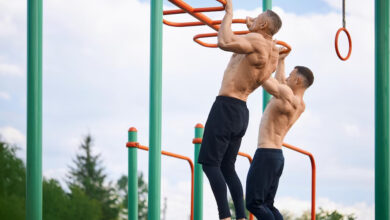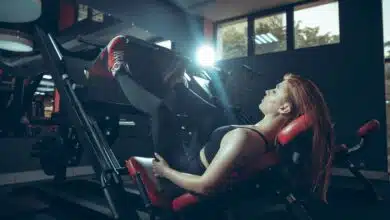Kettlebell Leg Workout: Get Stronger, Leaner Legs!

Introduction
Are you looking to strengthen and tone your leg muscles while achieving an overall fit and healthy physique? Look no further than the fantastic world of kettlebell leg workout! This article will guide you through the process of crafting a powerful leg workout routine using kettlebells. Whether you are a beginner or a seasoned fitness enthusiast, kettlebell exercises can provide numerous benefits to help you reach your fitness goals.
Kettlebell Leg Workout: Say Goodbye to Flabby Thighs and Hello to Confidence!
Benefits of Kettlebell Leg Workout
Kettlebell leg workouts offer a wide array of benefits that make them a popular choice among fitness enthusiasts. Some of the key advantages include:
- Strengthens Leg Muscles: Kettlebell leg exercises target major leg muscles like quadriceps, hamstrings, glutes, and calves, leading to increased strength and endurance.
- Functional Fitness: The movements involved in kettlebell leg workouts mimic everyday activities, improving your functional fitness and making daily tasks easier.
- Fat Burning: These workouts are highly effective for burning calories and fat, aiding in weight loss and achieving a leaner physique.
- Joint Stability: The dynamic movements in kettlebell exercises enhance joint stability and reduce the risk of injury.
- Time-Efficient: Kettlebell workouts are time-efficient, as they engage multiple muscle groups simultaneously, providing an effective full-body workout.
Getting Started with Kettlebell Leg Workout
Before diving into your kettlebell leg workout routine, there are a few essential steps to consider:
3.1 Choosing the Right Kettlebell
The appropriate kettlebell weight will depend on your fitness level. Beginners should start with a lighter kettlebell and gradually progress to heavier ones as they gain strength and confidence.
3.2 Warm-Up Exercises
Proper warm-up is crucial to prevent injuries and prepare your muscles for the workout ahead. Perform dynamic stretches and light cardio to get your blood flowing and your muscles loosened up.
Top Kettlebell Leg Workout
Let’s explore some of the best kettlebell exercises for your legs:
4.1 Goblet Squats
Goblet squats are an excellent exercise for beginners, targeting the quads, hamstrings, and glutes. Hold the kettlebell close to your chest, squat down, and return to the starting position.
4.2 Kettlebell Swings
Kettlebell swings engage the entire posterior chain and help improve hip power and explosiveness. Swing the kettlebell between your legs and thrust it forward using your hips and glutes.
4.3 Bulgarian Split Squats
This exercise works on each leg individually, enhancing balance and stability. Place one foot on a raised surface and perform squats with the other leg while holding the kettlebell.
4.4 Deadlifts
Deadlifts primarily target the hamstrings and glutes, promoting strength and stability in the lower body. Hold the kettlebell with both hands and lift it from the ground with a straight back.
4.5 Lunges
Lunges work on the quads, hamstrings, and glutes, while also improving balance and coordination. Hold the kettlebell in front of you and perform lunges with each leg.
4.6 Step-Ups
Step-ups are great for the quads and glutes. Step onto an elevated surface with one leg and bring the other knee up, holding the kettlebell for added resistance.
Structuring a Kettlebell Leg Workout Routine
Based on your fitness level, you can structure a kettlebell leg workout routine that suits your needs. Here are three sample routines for beginners, intermediates, and advanced fitness enthusiasts:
5.1 Beginner Routine
- Warm-up: 5-10 minutes of dynamic stretches and light cardio.
- Goblet Squats: 3 sets of 10 repetitions.
- Kettlebell Swings: 3 sets of 12 repetitions.
- Bulgarian Split Squats: 2 sets of 10 repetitions per leg.
- Rest between sets: 60 seconds.
5.2 Intermediate Routine
- Warm-up: 5-10 minutes of dynamic stretches and light cardio.
- Kettlebell Swings: 3 sets of 15 repetitions.
- Deadlifts: 3 sets of 8 repetitions.
- Lunges: Complete 2 sets of 12 repetitions for each leg.
- Step-Ups: Perform 2 sets of 10 repetitions for each leg.
- Rest between sets: 45 seconds.
5.3 Advanced Routine
- Warm-up: 5-10 minutes of dynamic stretches and light cardio.
- Deadlifts: 4 sets of 6 repetitions.
- Bulgarian Split Squats: Perform 3 sets of 8 reps for each leg.
- Kettlebell Swings: 4 sets of 12 repetitions.
- Lunges: Perform 3 sets of 10 lunges per leg.
- Step-Ups: 3 sets of 8 repetitions per leg.
- Rest between sets: 30 seconds.
Tips for Better Results
To maximize the benefits of your kettlebell leg workouts, keep these tips in mind:
6.1 Proper Form and Technique
Maintaining proper form during exercises is essential to avoid injuries and target the right muscles effectively.
6.2 Progression and Variation
Gradually increase the weight and intensity of your workouts to keep challenging your muscles. Additionally, incorporate different exercises to prevent boredom and keep your routine fresh.
6.3 Rest and Recovery
Ensure that your muscles have sufficient time to recover between exercise sessions. Rest is crucial for muscle growth and overall performance.
6.4 Nutrition
Pair your kettlebell leg workouts with a balanced diet to fuel your body with the nutrients it needs to perform optimally.
Avoiding Common Mistakes
To make the most out of your kettlebell leg workouts, steer clear of these common mistakes:
7.1 Overtraining
Excessive training without proper rest can lead to burnout and injuries. Pay attention to your body’s signals and allow it ample time for recovery.
7.2 Neglecting Mobility
Work on improving your mobility and flexibility, as this will enhance your overall performance and reduce the risk of injuries.
7.3 Not Using Proper Weight
Using a weight that is too light or too heavy can hinder your progress. Select a load that provides a challenge while enabling you to uphold correct posture and technique.
Staying Motivated and Consistent
Maintaining consistency and motivation are key to achieving your fitness goals:
8.1 Setting Goals
Set clear and achievable goals to track your progress and stay motivated throughout your fitness journey.
8.2 Tracking Progress
Keep a workout journal to monitor your improvements and celebrate your achievements.
8.3 Working Out with a Partner
Working out with a friend or a partner can add an element of fun and accountability to your kettlebell leg workouts.
Conclusion
In conclusion, kettlebell leg workouts are an excellent way to get stronger, leaner legs and improve your overall fitness. By following the outlined exercises and routines, staying consistent, and paying attention to proper form, you’ll be well on your way to achieving your fitness goals. Embrace the versatility of kettlebell exercises and enjoy the benefits they offer in your fitness journey.
Frequently Asked Questions (FAQs)
- Can I do kettlebell leg workouts every day?
- While it’s essential to remain active, allowing your leg muscles time to recover is crucial. Aim for 2-3 kettlebell leg workouts per week with rest days in between.
- How many repetitions and sets should I perform?
- The number of repetitions and sets will depend on your fitness level and goals. Beginners can start with 2-3 sets of 10-12 repetitions, while more advanced individuals can aim for 3-4 sets of 8-15 repetitions.
- Is it necessary to use heavy kettlebells for leg workouts?
- Not necessarily. The weight of the kettlebell should be challenging but manageable, allowing you to maintain proper form throughout the exercises.
- Can kettlebell leg workouts help with weight loss?
- Yes, kettlebell leg workouts are highly effective for burning calories and aiding in weight loss, especially when combined with a balanced diet.
- Can I incorporate kettlebell leg exercises into my existing workout routine?
- Absolutely! Kettlebell leg exercises can be seamlessly integrated into your current workout routine to add variety and target different muscle groups.




